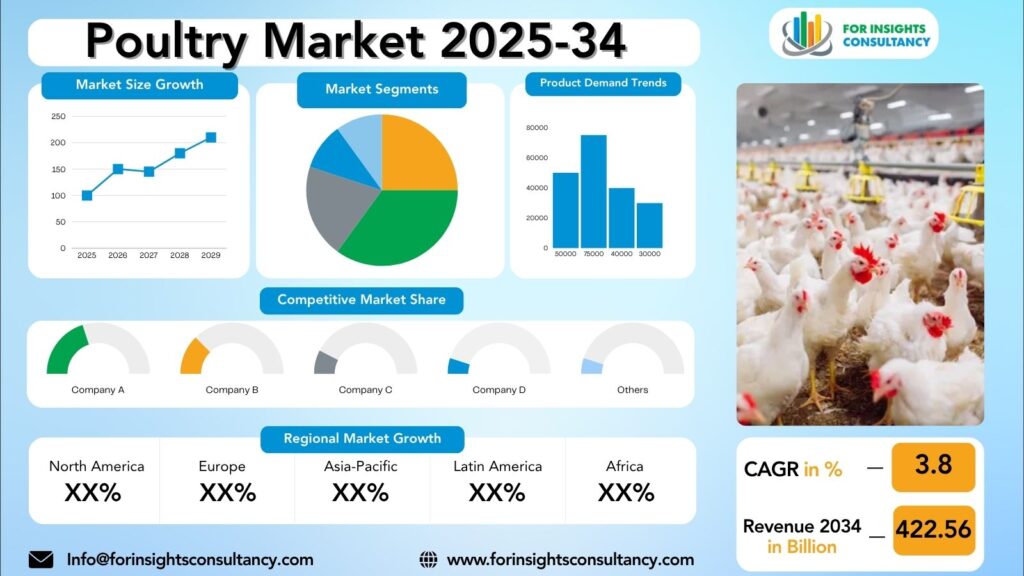
Poultry Market Size, Trends Analysis Research Report By Product/Application) (Meat Production, Egg Production), By Species Type (Chicken (Broilers for meat, Layers for eggs), Turkey, Duck, Geese, Quail, and Others), And by Consumer Preference/Nature(Conventional, Organic, Antibiotic-Free (No Antibiotics Ever - NAE)), and By Region Global Market Analysis And Forecast, 2025-2034
Sep-2025 Formats | PDF | Category: Food & Beverage | Delivery: 24 to 72 Hours
The report highlights that the market outlook is significantly influenced by swift shifts in global trade relations and tariffs. It emphasizes the necessity of updating the report before delivery to incorporate the most current status, which includes revised market forecasts and a comprehensive analysis of the quantified impacts of these changes. Specifically, the Recommendations and Conclusions sections will be enhanced to provide actionable strategies for organizations navigating the rapidly evolving international landscape.
Poultry Market Is Forecast to Increase from USD 375.86 Billion In 2025 To USD 422.56 Billion By 2034, At A CAGR Of 3.8%.
Poultry Market: A Comprehensive Overview and Future Developments
The poultry market is a crucial segment of the global food industry, significantly contributing to protein supply for billions of consumers. This overview examines the current trends, challenges, and opportunities influencing this sector. An increasing emphasis on sustainable practices and animal welfare is prompting the industry to adopt new technologies and enhanced production methods to satisfy the escalating demand while adhering to strict quality and safety standards.
Future developments in the poultry market will be influenced by various factors, including changing consumer preferences, evolving regulatory requirements, and advancements in supply chain management. Notable growth areas entail the rising demand for organic and antibiotic-free poultry products and the potential introduction of novel protein sources.
In summary, the poultry market is on the verge of transformation and innovation, fueled by a dedication to evolving alongside global needs and ensuring the welfare of consumers and animals alike.
AI Impact
The impact of artificial intelligence (AI) on the global poultry market is profound and extensive, marking a transformative shift in various facets of poultry farming. AI technology is enhancing breeding practices by allowing for more selective breeding based on genetic data, which leads to healthier and more productive flocks. Additionally, AI plays a crucial role in disease detection by utilizing advanced algorithms to identify health issues in poultry early, facilitating timely interventions that can prevent widespread outbreaks.
Moreover, AI optimizes feeding schedules and monitors animal health through real-time data analytics, leading to improved growth rates and reduced feed waste. The incorporation of precision farming techniques powered by AI enhances overall efficiency within the industry, allowing farmers to tailor their practices to specific needs of the animals and the conditions of their environments.
The operational costs for poultry farmers can be significantly lowered by leveraging AI, as it streamlines many everyday processes, thereby increasing productivity. Furthermore, as the technology progresses, it is anticipated that AI will continue to refine these practices, improve animal welfare, and address the ever-growing global demand for poultry products. In summary, the adoption of AI in poultry farming not only drives economic benefits but also fosters sustainable practices in the industry.
Market Dynamics
Trends
The poultry market is currently influenced by several significant trends that are reshaping the industry landscape. A notable shift is observed in consumer preferences, with a growing demand for organic and free-range poultry products. This shift is largely motivated by consumers’ desires for healthier and more environmentally sustainable food options. Consequently, there has been an increase in specialty poultry offerings, including organic chickens and heritage breed turkeys, which cater to this evolving market. Furthermore, convenience has become a prominent trend, with a substantial rise in the popularity of pre-packaged and ready-to-cook poultry products. Consumers are increasingly seeking products that offer ease of preparation alongside quality. Another critical aspect of this transformation is the heightened interest in transparency and traceability within the poultry supply chain. Consumers are now more inclined to inquire about the origins of their food and the methods of production used. This overall evolution reflects a market that is actively adapting to the changing preferences and priorities of modern consumers.
Growth Drivers
The Poultry Market is experiencing significant growth driven by several interrelated factors. A key driver is the increasing consumer awareness of the health benefits associated with poultry products, which has been enhancing demand. Additionally, the rise in disposable income levels among consumers is influencing dietary preferences, leading to a stronger inclination towards protein-rich foods, including poultry. Technological advancements in poultry farming—particularly automated systems for feeding and monitoring bird health—are also playing a crucial role in market development by improving efficiency and production standards. Furthermore, the trend towards organic and antibiotic-free poultry products is appealing to a growing demographic of health-conscious consumers, thereby further propelling market expansion. Collectively, these elements are promoting a positive growth trajectory for the Poultry Market.
Restraints
In the poultry market, several key restraints significantly impact production and profitability. Stringent regulations governing food safety and animal welfare contribute to increased production costs for poultry farmers, making compliance a financial burden. Furthermore, the threat of diseases such as avian flu can lead to temporary farm shutdowns, resulting in supply shortages and subsequent price instability in the market. Traditional poultry producers also face mounting competition from alternative protein sources, including plant-based meats, which have grown in popularity and market share. Additionally, rising feed costs combined with fluctuating market demand further complicate the operational landscape for poultry stakeholders. To effectively navigate these challenges, it is essential for market participants to adopt efficient risk management strategies and consider diversifying their product offerings, which can provide a buffer against the shifting dynamics of the poultry market.
Opportunities
The poultry market offers numerous opportunities for entrepreneurs, including small-scale and large-scale businesses. With increasing demand for eggs and meat, there is a growing market for innovative products and services in areas like organic farming, specialty products, supply chain optimization, health supplements, and technology solutions. The growing consumer interest in locally sourced and ethically raised poultry products also opens up niche market segments. Entrepreneurs can also explore expanding export markets to meet global demand for high-quality poultry. Overall, the poultry market provides a fertile ground for businesses to thrive and cater to consumer needs.
Challenges
Operating a poultry market entails navigating a series of complex challenges that can significantly impact business success. Key issues include maintaining high quality and freshness of poultry products, which is essential for customer satisfaction and safety. Market owners must also effectively manage inventory to minimize waste, particularly as demand can fluctuate due to various factors. Compliance with regulatory frameworks and safety standards is crucial, as any lapses can lead to severe penalties and reputational damage.
Moreover, poultry market operators face intense competition from other vendors, which necessitates the implementation of strategies to maintain competitive pricing. Balancing competitive prices while covering overhead costs can be difficult, particularly in a fluctuating market. To attract and retain customers amidst this competition, market owners need to invest in effective marketing and promotional campaigns that highlight product quality and unique selling propositions.
Establishing robust relationships with suppliers is another critical factor; reliable suppliers can help ensure consistent product quality and availability. Additionally, staying abreast of market trends allows poultry market owners to adapt to changing demands and consumer preferences. Ultimately, delivering excellent customer service is pivotal—it not only fosters customer loyalty but also enhances the market’s reputation in a highly competitive environment. By addressing these challenges proactively, poultry market owners can position themselves for sustainable growth and success.
Poultry Market Top Companies Covered In This Report:
Evaluate The Strategic Positioning And Innovation Pipelines Of Leading Market Companies-From Multinational Enterprises To Disruptive Regional Firms. Understand How Key Players Are Innovating, Expanding, And Capturing Value, And Use Competitive Benchmarks To Plan Your Next Move.
- Pilgrim’s Pride Corporation
- Wens Foodstuff Group Co. Ltd.
- BRF S.A.
- Tyson Foods, Inc.
- JBS S.A.
- Amrit Group
- Perdue Farms
- Sanderson Farms
- Baiada Poultry
- Bates Turkey Farm
Poultry Market Company News 2024 and 2025
Tyson Foods, Inc
Launched several new convenience-focused products, including Tyson Chicken Cups (portable, high protein) and Tyson Simple Ingredient Nuggets (simplified labels).
Clean Label Commitment: Announced plans to remove High Fructose Corn Syrup and other specific ingredients from its branded products.
Financial Outlook: Raised its full-year adjusted operating income guidance for the Chicken segment in 2025, with the chicken business being a strong performer.
Pilgrim’s Pride Corporation (majority owned by JBS)
Unveiled plans for a $400 million new prepared foods facility in Georgia, expected to begin construction in 2025.
JBS S.A.
Continued to face antitrust lawsuits. Reached a combined $127.3 million settlement with Tyson Foods regarding employee wage-fixing claims in early 2024.
Segmented View of The Industry:
The Poultry Market Is Mapped Through A Multidimensional Lens-Tracking Shifts Across Product Type, Applications, And Geographic Regions. This Segmented Approach Enables Businesses to Localize Their Growth Plans And Align Offerings With The Most Profitable Demand Centres.
Segmentation By Species Type
- Chicken (Broilers for meat, Layers for eggs)
- Turkey
- Duck
- Geese, Quail, and Others
Segmentation By Product/Application
- Meat Production
- Egg Production
Segmentation By Consumer Preference/Nature
- Conventional
- Organic
- Antibiotic-Free (No Antibiotics Ever – NAE)
Global Geographic Coverage:
Based On Recent Market Analysis, North America Is The Largest And Most Mature Market For Very Small Aperture Terminals (Vsat). Its Leading Position Is Driven By Significant Investments In Defense And Government Sectors And A Well-Established Telecommunications Infrastructure.
The Report Provides In-Depth Qualitative And Quantitative Data On The Poultry Market For All Of The Regions And Countries Listed Below:
North America
The poultry market in North America is an essential component of the region’s economy, with the United States leading as the largest producer. The U.S. poultry industry benefits from a robust infrastructure and cutting-edge technology, which collectively foster significant growth driven by rising consumer demand for high-quality and cost-effective poultry products. Canada also plays a vital role in this market, renowned for its stringent animal welfare practices and food safety regulations. The Canadian poultry sector emphasizes sustainability and innovation, ensuring the consistent production of safe and high-quality products. In contrast, Mexico’s poultry industry is rapidly expanding due to rising domestic consumption and burgeoning export opportunities. This growth is further supported by investments aimed at modernizing production facilities and enhancing breeding practices. Collectively, the North American poultry market exhibits a dynamic and competitive landscape, with each country uniquely contributing to its overall success.
Europe
Europe’s poultry market is a dynamic and diverse landscape, with each country contributing unique characteristics to the industry. Germany stands out as the largest market, where there is a growing demand for high-quality poultry products. The adoption of advanced technologies in poultry farming enhances production efficiency and distribution capabilities. In France, the emphasis on culinary traditions translates to a preference for organic and free-range poultry offerings, catering to health-conscious consumers. Spain benefits from a rich heritage of traditional poultry dishes and maintains a robust domestic market while also aiming at export opportunities within Europe. Meanwhile, Italy presents a wide assortment of poultry products, including specialty breeds and premium cuts, targeting more discerning customers. The United Kingdom places a strong focus on animal welfare standards in its poultry farming practices, which fosters consumer trust and confidence in the industry. Overall, Europe’s poultry market is marked by a blend of innovation, tradition, and quality, showcasing the diverse flavors and practices from various nations.
Asia Pacific
In the Asia Pacific region, the poultry market is experiencing remarkable growth, characterized by the unique developments of various countries. A detailed regional analysis reveals that China leads the market as the largest poultry producer, featuring a well-established industry that meets both domestic consumption and export demands. The nation offers a broad range of poultry products, with significant attention paid to quality and safety standards.
India’s poultry industry is currently on an upward trajectory, fueled by a surge in demand for poultry products and evolving consumer preferences. The market comprises numerous small-scale poultry farms, which play a crucial role in its expansion.
Other countries, including Thailand, Indonesia, and Vietnam, are emerging as significant contributors to the poultry landscape in Asia Pacific. These nations are capitalizing on technological advancements and innovative practices to enhance production capabilities and fulfill the increasing demand for poultry.
In summary, the Asia Pacific poultry market stands out for its dynamism and potential, presenting numerous opportunities for growth and expansion in the years ahead.
Middle East and Africa
The poultry market in the Middle East and Africa is experiencing significant growth, with each country in the region contributing uniquely to its development. In the Middle East, nations such as Saudi Arabia and the UAE are seeing a marked increase in poultry consumption, driven by factors like population growth and rising disposable incomes. These countries have also put in place stringent regulations to maintain the quality and safety of poultry products.
Conversely, in Africa, key players include Nigeria and South Africa. Nigeria boasts a large population along with increasing urbanization, creating a substantial demand for poultry products, which has spurred a surge in poultry farming and production. South Africa stands out as one of the largest poultry producers within the region, benefitting from modern facilities and advanced technologies that enhance its poultry market growth.
The overall landscape of the poultry market in the Middle East and Africa presents a mix of diverse opportunities and challenges, as each country amplifies the dynamic and evolving nature of the sector.
Reasons To Buy:
- The Research Would Help Top Administration/Policymakers/Professionals/Product Advancements/Sales Managers And Stakeholders In This Market In The Following Ways.
- The Report Provides Poultry Market Revenues At The Worldwide, Regional, And Country Levels With A Complete Analysis To 2034 Permitting Companies To Analyze Their Market Share And Analyze Projections, And Find New Markets To Aim For.
- To Understand The Most Affecting Driving And Restraining Forces In The Market And Their Impact On The Global Market.
- Major Changes And Assessment In Market Dynamics And Developments.
- The Objective Of The Poultry Market Report Is To Identify New Business Opportunities Using Quantitative Market Forecasts.
- Formulate Sales And Marketing Strategies By Gaining An Understanding Of Competitors, Their Positioning, And Strengths & Weaknesses.
Faq – What Global Leaders Are Asking
What Is The Growth Prospect For The Poultry Market By 2034?
Poultry Market Is Expected To Achieve A Stable Growth Rate With A Compound Annual Growth Rate (CAGR) Of About 3.8% From 2025 Through 2034.
What Is Driving The Growth Of The Poultry Market?
The market’s growth is primarily driven by its affordability and efficiency compared to other meats, combined with rising global populations and increasing disposable incomes in emerging economies.
Who Are The Key Players In The Poultry Market, And What Are Their Market Shares?
The Poultry Market Includes Major Companies Like Pilgrim’s Pride Corporation, Wens Foodstuff Group Co. Ltd., BRF S.A., Tyson Foods, Inc., JBS S.A., Amrit Group, Perdue Farms, Sanderson Farms, Baiada Poultry, Bates Turkey Farm, Others.
Specific Market Share Data Is Not Publicly Available And Is Typically Provided In Detailed, Proprietary Market Research Reports.
Which Regions Are Leading The Poultry Market Growth?
Asia-Pacific is the largest and fastest-growing region, driven by its massive population, rising disposable incomes, and increasing meat consumption. Strong growth is also seen in Latin America (led by major exporter Brazil) and the Middle East & Africa, fueled by urbanization and poultry’s affordability as a protein source.
Customization: We Can Provide Following Things
1) On Market More Company Profiles (Competitors)
2) Data About Particular Country Or Region
3) We Will Incorporate The Same With No Additional Cost (Post Conducting Feasibility).
Any Requirement Contact Us: Https://Www.Forinsightsconsultancy.Com/Contact-Us/
Table of Contents
For TOC Contact us: https://forinsightsconsultancy.com/contact-us/







